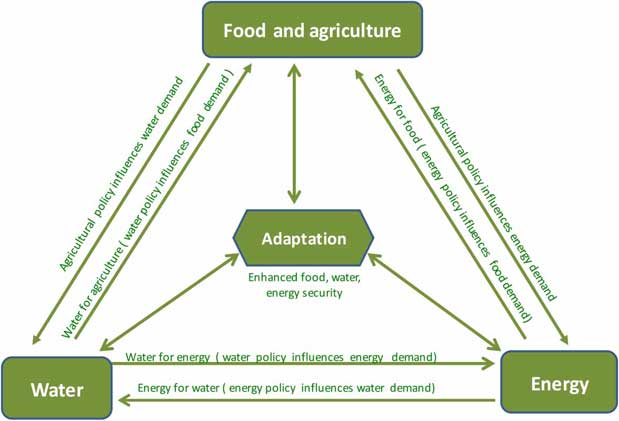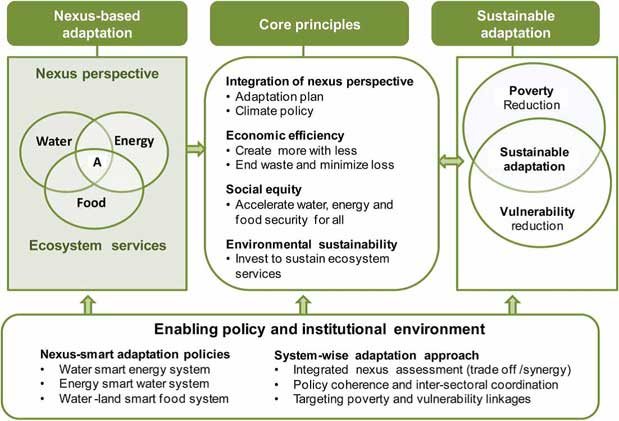By Tiku Gauchan
Climate change in the Hindu Kush Himalaya (HKH) can have and has had adverse impacts on the food, water and energy needs of large segments of the population, (especially the most vulnerable ones) living in the region and the areas that depend on the ecosystems in the HKH. To help the people cope with the impacts of climate change, we have over the years resorted to a host of adaptation measures. But how we come up with these adaptation measures may need to be overhauled because many of them are designed without taking into account how food, water and energy needs impact one another. Focusing solely on one aspect of the food, energy and water equation can have detrimental effects on the other sectors. That is why it is recommended that we use what is called the food, water and energy Nexus Approach as a framework through which to approach how we design sustainable adaptation measures and adaptation policies. The Nexus Approach takes into account each of the sectors, and using the framework, we try to come up with the optimal climate-smart initiatives, policies and adaptation techniques.
 Figure 1 The interfaces among water, energy, food, and adaptation
Figure 1 The interfaces among water, energy, food, and adaptation
The approaches used to design adaptation measures have evolved over the years. In the 1990s, the goal was to reduce climate risks and the impacts of climate change on the people; in the 2000s, the goal was to reduce risks and uncertainties; since 2010, the adaption measures have also taken into account people’s socio-economic conditions and adaptation has been aligned with developmental goals. In the 1990s, adaptation measures were mostly sector- and location- specific; in the 2000s, adaptation measures were still sector-based but they now included the larger sector’s overall plans; after 2010, adaptation measures are increasingly designed through approaches that take in account both trans-sector and trans-boundary realities. In the 1990s, adaptation measures mostly focused on protecting the most vulnerable; in the 2000s, the focus shifted to preventing damaging strategies arising from risks to climate-sensitive livelihoods; after 2010, the focus is on transformative strategies that build the people’s adaptive capacity, transform social relations and address their social and political vulnerability.
The Nexus Approach builds on all these learnings and seeks to improve on them. Instead of having a narrow sectoral, site-specific boundary-confined outlook, it seeks to create a cross-sectoral, system-wide approach. It seeks to provide a framework for assessing trade-offs and synergies among the various sectors. Specifically, it focuses on improving resource-use efficiency, reducing trade-offs among the various sectors and improving the synergies among them. It further seeks to create adaptation measures that bring benefits to all three sectors while at the same time remaining aligned with the larger developmental goals.
The problem with the older sector-specific approaches is that focusing on just one of the sectors can create new challenges for the other sectors. For example, focusing just on energy needs might lead to the building of large dams, which can adversely affect the irrigation networks used by farmers who depend on the dammed water to water their crops. Focusing on just food security might lead to planners’ recommending water-intensive crop farming methods that could have an adverse effect on the water-resource availability in the long run. And focusing just on water needs could lead to the use of fuel resources for pumping and distributing water that may be expensive to procure.
The Nexus Approach creates a framework that takes into account the competition for resources and seeks to find ways that optimise the use of resources while at the same time benefiting all the sectors. The Nexus Approach seeks to reduce resource waste and increase economic efficiency to create sustainable adaptation measures. The approach seeks to provide integrated solutions at the local levels, and through policy initiatives, at the state levels and cross-boundary levels. It seeks to do this by engaging all the pertinent stakeholders and by encouraging public-private partnerships when creating adaptation measures.
 Figure 2. Outline for a nexus-based adaptation framework
Figure 2. Outline for a nexus-based adaptation framework
Ultimately, the Nexus Approach can be used to create climate-smart policies that accomplish both adaptation and developmental goals. The policies will need to be created by collaborative efforts among all stakeholders. To enable the creation of such climate-smart and development-oriented policies, there needs to be much research conducted on reducing the trade-offs and enhancing the benefits across the sectors. The policy planners and stakeholders will need to internalise the reality of cross-sectoral impacts of adaptation measures on adaptation and developmental goals. Overall, using the Nexus Approach, the policies thus created should benefit both the most vulnerable populations in the HKH region and the people dependent on its resources.
Note: The above explanatory writing is based on:
Golam Rasul & Bikash Sharma (2015): The nexus approach to water–energy–food security: an option for adaptation to climate change, Climate Policy
